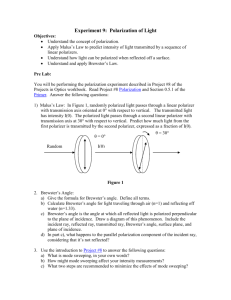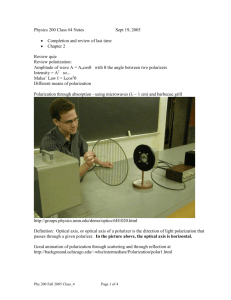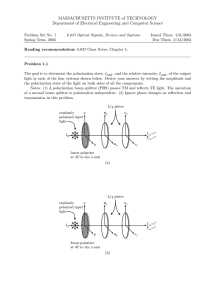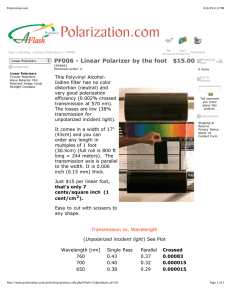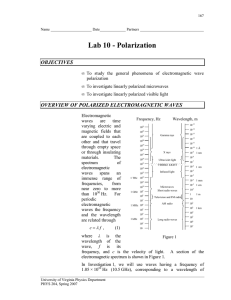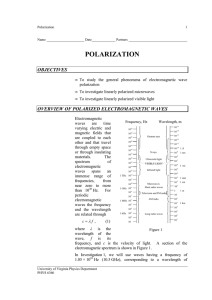VSRT M #032 MASSACHUSETTS INSTITUTE OF TECHNOLOGY
advertisement
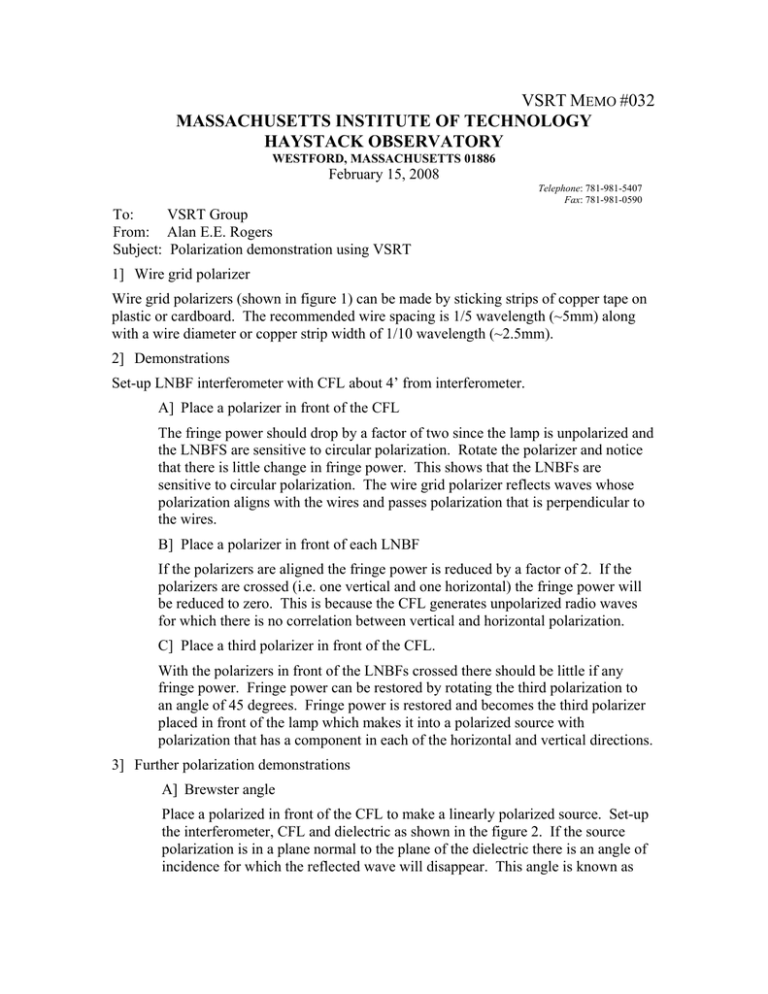
VSRT MEMO #032 MASSACHUSETTS INSTITUTE OF TECHNOLOGY HAYSTACK OBSERVATORY WESTFORD, MASSACHUSETTS 01886 February 15, 2008 Telephone: 781-981-5407 Fax: 781-981-0590 To: VSRT Group From: Alan E.E. Rogers Subject: Polarization demonstration using VSRT 1] Wire grid polarizer Wire grid polarizers (shown in figure 1) can be made by sticking strips of copper tape on plastic or cardboard. The recommended wire spacing is 1/5 wavelength (~5mm) along with a wire diameter or copper strip width of 1/10 wavelength (~2.5mm). 2] Demonstrations Set-up LNBF interferometer with CFL about 4’ from interferometer. A] Place a polarizer in front of the CFL The fringe power should drop by a factor of two since the lamp is unpolarized and the LNBFS are sensitive to circular polarization. Rotate the polarizer and notice that there is little change in fringe power. This shows that the LNBFs are sensitive to circular polarization. The wire grid polarizer reflects waves whose polarization aligns with the wires and passes polarization that is perpendicular to the wires. B] Place a polarizer in front of each LNBF If the polarizers are aligned the fringe power is reduced by a factor of 2. If the polarizers are crossed (i.e. one vertical and one horizontal) the fringe power will be reduced to zero. This is because the CFL generates unpolarized radio waves for which there is no correlation between vertical and horizontal polarization. C] Place a third polarizer in front of the CFL. With the polarizers in front of the LNBFs crossed there should be little if any fringe power. Fringe power can be restored by rotating the third polarization to an angle of 45 degrees. Fringe power is restored and becomes the third polarizer placed in front of the lamp which makes it into a polarized source with polarization that has a component in each of the horizontal and vertical directions. 3] Further polarization demonstrations A] Brewster angle Place a polarized in front of the CFL to make a linearly polarized source. Set-up the interferometer, CFL and dielectric as shown in the figure 2. If the source polarization is in a plane normal to the plane of the dielectric there is an angle of incidence for which the reflected wave will disappear. This angle is known as the Brewster angle or Brewster’s angle after Brewster (1781-1868). Snell’s law of refraction is n1 sin θ1 = n2 sin θ 2 where θ1 and θ 2 are the angles of incidence and refraction respectively and n, and n2 are the refractive indices. When the reflected ray is perpendicular to the refracted ray. θ1 + θ 2 = 90° and the reflected ray is minimized because the radiation patter for the induced dipole radiation in the dielectric is at a null.. Solving (1) and (2) Brewster Angle = θ1 = tan −1 ( n2 n2 ) For plexiglass ( n2 3) the Brewster angle is about 71 degrees. Figure 3 shows the set-up for the Brewster angle measurement. The polarization can be set by placing polarized in front of each feed as shown in figure 4 or by placing and rotating a single polarizer in front of the lamps as shown in figure 5. The determination of the angle of incidence which minimizes the reflection of the vertically polarized wave (i.e. Brewster’s angle) requires a high degree of skill in getting an accurate setup and then adjusting the setup for difference angles of incidence. What I have shown in this memo is just a demonstration of how it can be done. Designing a setup to cover a range of angles and then making the measurements is a substantial project. Fig. 1. “Wire grid” polarizers made by placing strips of 3 m adhesive backed copper tape onto cardboard. The polarizers have a spacing of 5 mm between strips and a nominal strip width of 2.5 mm. Fig. 2. Setup to examine the reflection from a dielectric plate. Fig. 3. Photograph of the setup shown schematically in figure 2. If need a metal plate can be used to block any direct radio waves from the lamp to the feeds. Fig. 4. Setup showing computer screen Fig. 5. The polarization can be set either by placing a polarizer over each LNBF or by placing a single polarizer in front of the lamp as shown in this photograph.


